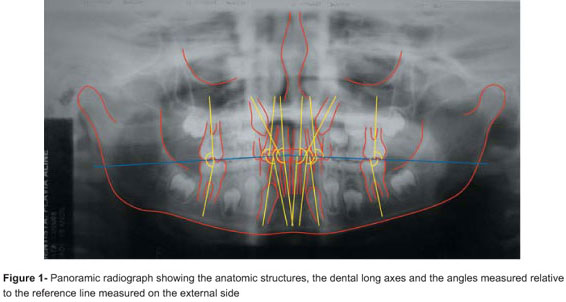OBJECTIVE: There is little information regarding the mesiodistal angulation of permanent teeth in mixed dentition. The aim of this study was to evaluate mesiodistal root angulation of permanent incisors, canines and first molars of 100 Brazilian children, using a new horizontal reference plane based on the midpoint of the intercuspation of primary canines and permanent first molars in panoramic radiographs during the mixed-dentition phase. MATERIAL AND METHODS: Children were equally divided between the genders with a mean age of 8.9 years (SD=0.76), normal occlusion and no eruptive disturbances. RESULTS: The angulation of the permanent maxillary first molars was close to the vertical, whereas the mandibular molars presented approximately 25 degrees of distal root angulation. The maxillary canines were the most distally angulated teeth, whereas the permanent mandibular canines were vertically positioned. The evaluation of the anterior maxillary area showed vertical position of permanent lateral, and central incisors with a slight distal angulation, whereas the permanent mandibular incisors tended to a mesial radicular convergence. CONCLUSIONS: The proposed reference line could be useful in mixed dentition root angulation evaluation; there was a slight asymmetry in the mesiodistal angulation among homologous teeth, and also a small variation between the male and the female groups, but no difference between 8-and 10-year-old children.
Panoramic radiography; Mixed dentition; Interceptive orthodontics; Dental occlusion



